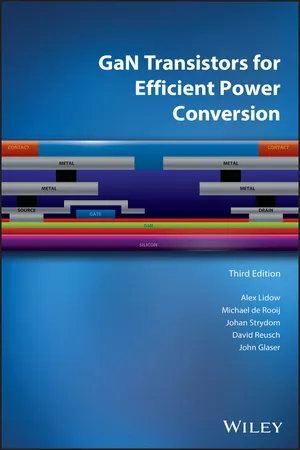
GaN Transistors for Efficient Power Conversion
- English
- ePUB (mobile friendly)
- Available on iOS & Android
GaN Transistors for Efficient Power Conversion
About this book
An up-to-date, practical guide on upgrading from silicon to GaN, and how to use GaN transistors in power conversion systems design
This updated, third edition of a popular book on GaN transistors for efficient power conversion has been substantially expanded to keep students and practicing power conversion engineers ahead of the learning curve in GaN technology advancements. Acknowledging that GaN transistors are not one-to-one replacements for the current MOSFET technology, this book serves as a practical guide for understanding basic GaN transistor construction, characteristics, and applications. Included are discussions on the fundamental physics of these power semiconductors, layout, and other circuit design considerations, as well as specific application examples demonstrating design techniques when employing GaN devices.
GaN Transistors for Efficient Power Conversion, 3rd Edition brings key updates to the chapters of Driving GaN Transistors; Modeling, Simulation, and Measurement of GaN Transistors; DC-DC Power Conversion; Envelope Tracking; and Highly Resonant Wireless Energy Transfer. It also offers new chapters on Thermal Management, Multilevel Converters, and Lidar, and revises many others throughout.
- Written by leaders in the power semiconductor field and industry pioneers in GaN power transistor technology and applications
- Updated with 35% new material, including three new chapters on Thermal Management, Multilevel Converters, Wireless Power, and Lidar
- Features practical guidance on formulating specific circuit designs when constructing power conversion systems using GaN transistors
- A valuable resource for professional engineers, systems designers, and electrical engineering students who need to fully understand the state-of-the-art
GaN Transistors for Efficient Power Conversion, 3rd Edition is an essential learning tool and reference guide that enables power conversion engineers to design energy-efficient, smaller, and more cost-effective products using GaN transistors.
Frequently asked questions
- Essential is ideal for learners and professionals who enjoy exploring a wide range of subjects. Access the Essential Library with 800,000+ trusted titles and best-sellers across business, personal growth, and the humanities. Includes unlimited reading time and Standard Read Aloud voice.
- Complete: Perfect for advanced learners and researchers needing full, unrestricted access. Unlock 1.4M+ books across hundreds of subjects, including academic and specialized titles. The Complete Plan also includes advanced features like Premium Read Aloud and Research Assistant.
Please note we cannot support devices running on iOS 13 and Android 7 or earlier. Learn more about using the app.
Information
1
GaN Technology Overview
1.1 Silicon Power Metal Oxide Silicon Field Effect Transistors 1976–2010
1.2 The Gallium Nitride Journey Begins
Table of contents
- Cover
- Table of Contents
- Foreword
- Acknowledgments
- 1 GaN Technology Overview
- 2 GaN Transistor Electrical Characteristics
- 3 Driving GaN Transistors
- 4 Layout Considerations for GaN Transistor Circuits
- 5 Modeling and Measurement of GaN Transistors
- 6 Thermal Management
- 7 Hard‐Switching Topologies
- 8 Resonant and Soft‐Switching Converters
- 9 RF Performance
- 10 DC–DC Power Conversion
- 11 Multilevel Converters
- 12 Class D Audio Amplifiers
- 13 Lidar
- 14 Envelope Tracking
- 15 Highly Resonant Wireless Power
- 16 GaN Transistors for Space Applications
- 17 Replacing Silicon Power MOSFETs
- Appendix Glossary of Terms
- Index
- End User License Agreement